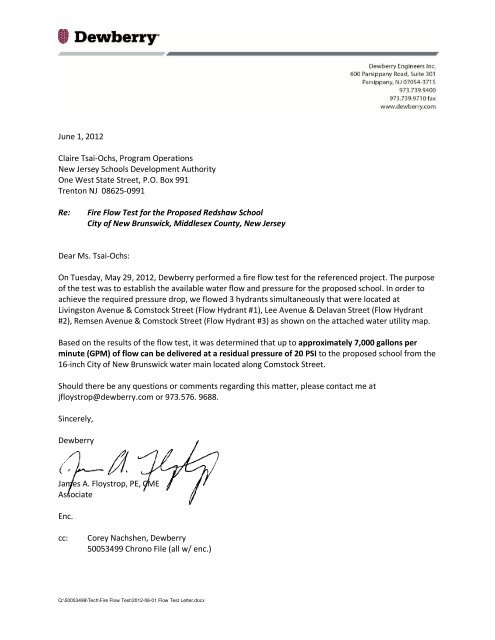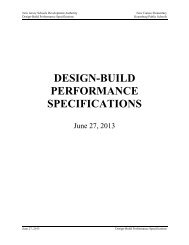02d Hydrant Flow Test Report_20120601.pdf
02d Hydrant Flow Test Report_20120601.pdf
02d Hydrant Flow Test Report_20120601.pdf
Create successful ePaper yourself
Turn your PDF publications into a flip-book with our unique Google optimized e-Paper software.
June 1, 2012<br />
Claire Tsai-Ochs, Program Operations<br />
New Jersey Schools Development Authority<br />
One West State Street, P.O. Box 991<br />
Trenton NJ 08625-0991<br />
Re:<br />
Fire <strong>Flow</strong> <strong>Test</strong> for the Proposed Redshaw School<br />
City of New Brunswick, Middlesex County, New Jersey<br />
Dear Ms. Tsai-Ochs:<br />
On Tuesday, May 29, 2012, Dewberry performed a fire flow test for the referenced project. The purpose<br />
of the test was to establish the available water flow and pressure for the proposed school. In order to<br />
achieve the required pressure drop, we flowed 3 hydrants simultaneously that were located at<br />
Livingston Avenue & Comstock Street (<strong>Flow</strong> <strong>Hydrant</strong> #1), Lee Avenue & Delavan Street (<strong>Flow</strong> <strong>Hydrant</strong><br />
#2), Remsen Avenue & Comstock Street (<strong>Flow</strong> <strong>Hydrant</strong> #3) as shown on the attached water utility map.<br />
Based on the results of the flow test, it was determined that up to approximately 7,000 gallons per<br />
minute (GPM) of flow can be delivered at a residual pressure of 20 PSI to the proposed school from the<br />
16-inch City of New Brunswick water main located along Comstock Street.<br />
Should there be any questions or comments regarding this matter, please contact me at<br />
jfloystrop@dewberry.com or 973.576. 9688.<br />
Sincerely,<br />
Dewberry<br />
James A. Floystrop, PE, CME<br />
Associate<br />
Enc.<br />
cc:<br />
Corey Nachshen, Dewberry<br />
50053499 Chrono File (all w/ enc.)<br />
Q:\50053499\Tech\Fire <strong>Flow</strong> <strong>Test</strong>\2012-06-01 <strong>Flow</strong> <strong>Test</strong> Letter.docx
FLOW TEST REPORT & CALCULATIONS<br />
Date of <strong>Test</strong>: 5/29/2012<br />
Time of <strong>Test</strong>:<br />
11:00 AM<br />
<strong>Test</strong> By: Daniel Rocha, Justin Fraser, David Revette, Eric Messina &<br />
New Brunswick Water Utility<br />
Location of<br />
<strong>Flow</strong> <strong>Hydrant</strong>:<br />
Livingston Ave & Comstock St (<strong>Flow</strong> <strong>Hydrant</strong> #1), Lee Ave & Delavan<br />
St (<strong>Flow</strong> <strong>Hydrant</strong> #2), Remsen Ave & Comstock St (<strong>Flow</strong> <strong>Hydrant</strong> #3)<br />
Location of<br />
Residual <strong>Hydrant</strong>: Comstock & Lee Ave<br />
Size of Water Main:<br />
16 Inches<br />
TEST DATA: <strong>Flow</strong> <strong>Hydrant</strong> #1<br />
Diameter of Nozzle:<br />
Pitot Pressure:<br />
4.25 Inches<br />
14 PSI<br />
0.9 for smooth and rounded<br />
0.8 for square and sharp<br />
0.7 for square and sharp with<br />
projection into barrel<br />
Q = 29.8 x C d x D 2 x P 0.5<br />
Outlet Nozzle<br />
Coefficient: 0.90 Where:<br />
Q = <strong>Flow</strong> in gallons per minute<br />
<strong>Flow</strong>: 1,813 GPM D = Diameter of Nozzle in inches<br />
P = Pitot Pressure (PSI)<br />
C d = Outlet Nozzle Coefficient<br />
TEST DATA: <strong>Flow</strong> <strong>Hydrant</strong> #2<br />
Diameter of Nozzle:<br />
Pitot Pressure:<br />
2.50 Inches<br />
13 PSI<br />
Outlet Nozzle<br />
Coefficient: 0.90<br />
<strong>Flow</strong>:<br />
604 GPM
TEST DATA: <strong>Flow</strong> <strong>Hydrant</strong> #3<br />
Diameter of Nozzle:<br />
Pitot Pressure:<br />
2.50 Inches<br />
35 PSI<br />
Outlet Nozzle<br />
Coefficient: 0.80<br />
<strong>Flow</strong>:<br />
881 GPM<br />
TEST DATA: Residual <strong>Hydrant</strong><br />
Static Pressure:<br />
Residual Pressure:<br />
Total <strong>Flow</strong>:<br />
61 PSI<br />
51 PSI<br />
3,298 GPM<br />
PROJECTED AVAILABLE FLOW<br />
= h 0.54<br />
0.54<br />
h <br />
Q R = flow predicted at desired residual pressure (desired residual pressure = 20 PSI)<br />
Q F = total flow measured during test<br />
h r = pressure drop to desired residual pressure (Static Pressure - 20 PSI)<br />
h f = pressure drop measured during test (Static Pressure - Residual Pressure)<br />
Q R =<br />
Q F =<br />
h r =<br />
h f =<br />
7,067 GPM<br />
3,298 GPM<br />
41 PSI<br />
10 PSI<br />
Approximately 7,000 GPM of flow should be available at a residual pressure of 20 PSI<br />
when rounded down to the nearest 250 GPM.




